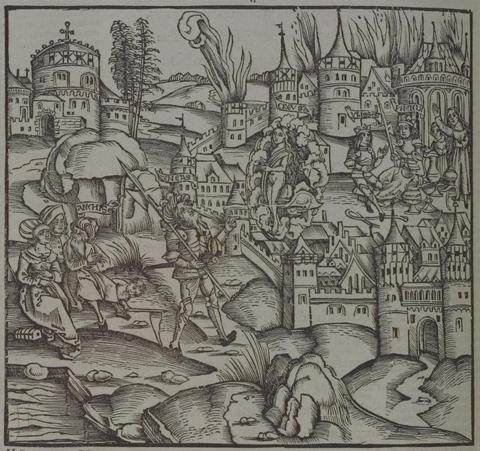Annotations
On the right, Ulysses and Phoenix stand in the sanctuary of Juno guarding their spoils, which include golden bowls, armor or clothing, and a woman and child (761-6). In the center, Aeneas looks up at Creusa who appears above the city wall and speaks to him (771-89). There is virtually no emotion expressed by either Aeneas or Creusa in the image, despite Virgil's decription of Creusa crying and Aeneas trying to hug the shade of his wife (790-4). On the left, Anchises sits with two other refugees. The baby figure holding a pennant next to Anchises' leg must be Brant's representation of the Penates. (Katy Purington)
Woodcut illustration from the “Strasbourg Vergil,” edited by Sebastian Brant: Publii Virgilii Maronis Opera cum quinque vulgatis commentariis expolitissimisque figuris atque imaginibus nuper per Sebastianum Brant superadditis (Strasbourg: Johannis Grieninger, 1502), fol. 181v, executed by an anonymous engraver under the direction of Brant.


Sebastian Brant (1458–1521) was a humanist scholar of many competencies. Trained in classics and law at the University of Basel, Brant later lectured in jurisprudence there and practiced law in his native city of Strasbourg. While his satirical poem Das Narrenschiff won him considerable standing as a writer, his role in the transmission of Virgil to the Renaissance was at least as important. In 1502 he and Strasbourg printer Johannes Grüninger produced a major edition of Virgil’s works, along with Donatus’ Life and the commentaries of Servius, Landino, and Calderini, with more than two hundred woodcut illustrations. (Annabel Patterson)